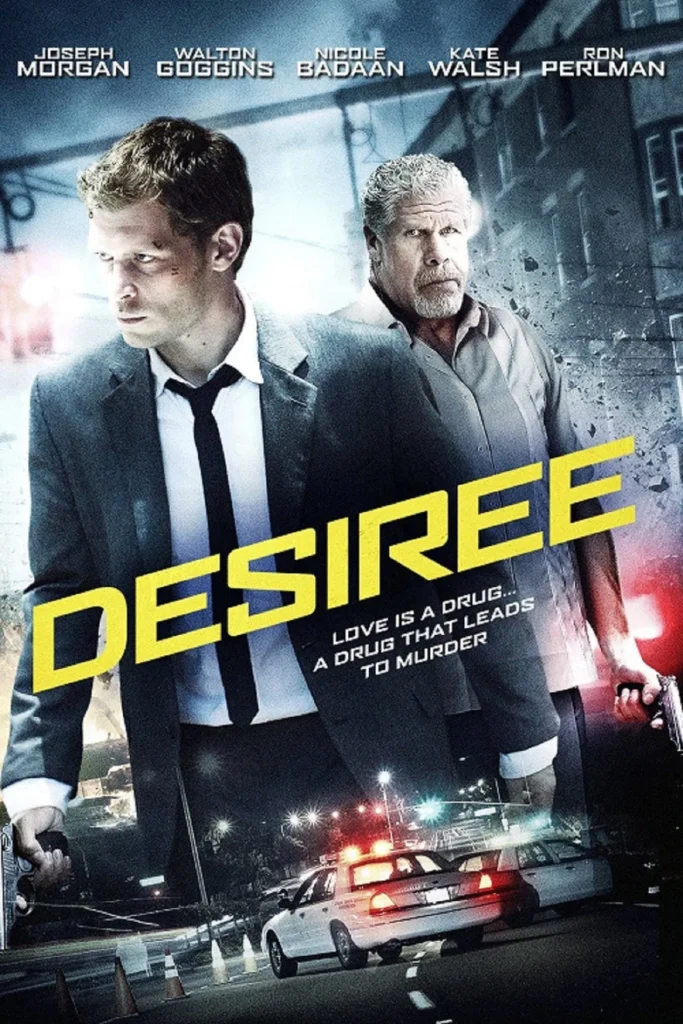
Background
Desiree (originally titled Dermaphoria) is British filmmaker Ross Clarke’s feature directorial debut, adapted from Craig Clevenger’s cult novel. Clarke – previously known for the documentary Skid . The film premiered to a “great response” at London’s East End Film Festival in 2014, marking Clarke’s jump from doc to fiction. British film site Cinemazero praised the movie’s visuals as “stunning”, and Screen International dubbed it a “freewheelingly moody, mysterious and often hallucinogenic film that mixes film noir with psychological drama”. In short, Clarke set out to turn Dermaphoria into a dark, dreamlike thriller of memory and loss in New Orleans, and by 2016 it saw a straight-to-VOD/DVD release in the U.S. (about two years after its festival debut)
Plot & Characters
Joseph Morgan plays Eric Ashworth, an experimental chemist who wakes up disoriented in a New Orleans jail, accused of setting fire to an illegal drug lab. Suffering from complete amnesia, Eric only remembers a mysterious lover named Desiree. When he’s (mysteriously) bailed out by an unseen benefactor, Eric obsessively searches the city for clues to his past—and for Desiree herself. Along the way he encounters detective Anslinger (Ron Perlman, in a brief but memorable cameo) and blustery fixer Blanc (Walton Goggins), both of whom seem to be pulling strings in the background. He also crosses paths with shady nightclub owner Morell (Kate Walsh) and other strange characters as fragmented flashbacks start to surface. The narrative unfolds in tight, often nightmarish sequences: Eric’s memories and present merge in surreal hallucinogenic scenes.
Eric is an anguished, reactive hero; Morgan (best known as TV’s Klaus Mikaelson on The Vampire Diaries) plays him as lost and desperate. Nicole Badaan’s Desiree appears initially as an enigmatic, almost spectral presence in Eric’s flashbacks and fantasies. Clarke treats Desiree as both obsession and puzzle – she’s shown in sultry, ambiguous scenes, leaving us unsure of what really happened between them. In this way the film becomes as much about Eric’s psychology as about Desiree herself.
Performances
Reviews note that “Joseph Morgan is impressive as the confused Eric” and that “Nicole Badaan is suitably sultry as Desiree”. Indeed, Morgan’s wounded intensity anchors the film’s empathy, while Badaan conveys Desiree’s seductive mystery in brief but striking glimpses. The supporting cast adds texture: Walton Goggins, though in a smaller role, brings his characteristic charm to Blanc (a fixer from Eric’s past), and Ron Perlman appears as a grizzled cop named Anslinger. Even in limited screentime, Perlman and Goggins lend the production a bit of class and familiarity. The minor characters (like Kate Walsh’s Morell) underscore the film’s seedy underbelly, but it’s Morgan and Badaan who carry the emotional weight of the story.
Cinematography & Style
Pedro Luque’s cinematography is a highlight, bathing Desiree in a noirish, otherworldly glow. The film was shot on location in humid New Orleans, and it often evokes classic Southern Gothic-thrillers (Alan Parker’s Angel Heart is an obvious reference). Streetlamps glow on misty roads, neon flickers in seedy bars, and light often isolates characters in darkness. Clarke favors “stylish and evocative moodiness over familiar vistas,” so the visuals are the film’s backbone. Scenes frequently shift into distorted, dreamlike imagery – flashbacks are shot with smeared focus or sudden jagged cuts, reflecting Eric’s fractured memory. Critics noted the cinematography as “stunning” and praised the eerie, hallucinogenic atmosphere, comparing Desiree to Lynchian thrillers.
Luque often frames New Orleans as both beautiful and claustrophobic. Bayou locations and urban streets shimmer, but characters also move through tight interiors and dim corridors, heightening paranoia. The editing by Darrin Navarro complements this, with jarring cuts during drug-induced sequences. Composer Bill Brown’s score – a sparse blend of piano and drones – further reinforces the film’s dreamlike vibe. In sum, Desiree is a visual experience first and foremost: it’s less a conventional narrative than an extended mood piece of “loss and memory”, with hallucinatory passages meant to unnerve the viewer as much as the protagonist.
Reception & Ratings
Desiree remains a very niche title. Major aggregators show scant numbers: it has an IMDb user rating around 4.7/10, and Rotten Tomatoes lists 0 reviews (no Tomatometer), so no official critics’ score. The limited feedback that exists is mixed. ScreenDaily gave a generally positive review of Dermaphoria (as it was then called), calling it intriguing and praising its atmosphere. Composer Bill Brown’s interview quotes mention festival buzz and highlight the film’s visual praise, but few other English-language outlets reviewed it. Audience response tends to be tepid; those who’ve seen it often describe it as “surreal” or confusing. (One IMDb user even called it “horrendous trash,” highlighting the divide.) In short, Desiree is largely unnoticed by mainstream critics, and among horror/thriller fans it has more of a cult curiosity status. Non-English markets offer little data: Egyptian cinema site elCinema lists it under Dermaphoria with no user reviews. The paucity of reviews suggests the film never found a wide audience.
Box Office & Availability
Desiree had almost no theatrical run and no publicized box office. After its festival outings (East End 2014 and others), it was released on home video. By late 2016 it became available on VOD and DVD. Today the film is easily streamed or rented online. JustWatch reports it’s streaming free-with-ads on The Roku Channel and Fandango at Home, and free-with-ads on Amazon Prime Video. It’s also up for purchase or rental on Amazon Video and Fandango’s platforms. In other words, while it never broke into cinemas, Desiree is widely accessible via streaming.
Verdict
Desiree is an ambitious indie thriller that lives and dies by its mood. Ross Clarke’s film packs in a moody New Orleans setting and a promising genre concept (amnesia, a missing lover, a mysterious drug). Joseph Morgan delivers a convincingly haunted lead performance and Nicole Badaan’s Desiree is appropriately seductive and unsettling. Where the film falters is in coherence: plot threads sometimes feel underdeveloped, and the narrative can be obscure. Fans of psychological horror will appreciate its style – the cinematography and score craft a genuine sense of noirish dread – but those expecting a straightforward mystery may find it confusing. On balance, Desiree comes across as a mixed bag: a visually striking indie with strong atmosphere but uneven payoff.
Rating: ★★★☆☆ (6/10)
Desiree may not be for everyone, but for lovers of art-house thrillers it offers an interesting, if imperfect, late-night dreamscape.
